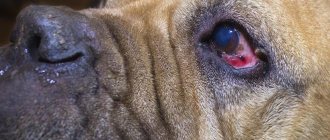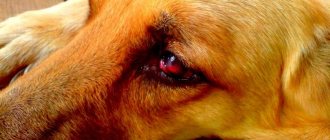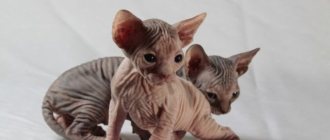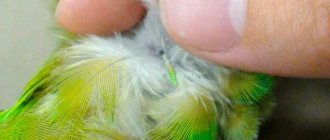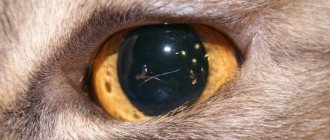Causes of the phenomenon
The dog's eyes do not literally fall out.
They extend beyond the orbit and, due to spasm of the eyelids, cannot return to their normal position. This phenomenon is called eyeball luxation or ptosis. It is accompanied by swelling of the tissue around the eye socket, obstruction of blood flow and drying of the cornea. The Pekingese's eyes in their natural state are always slightly protruding, so they are less protected from wind and dust, and they often lack moisture. They are very easy to injure – just a small push or pressure on the dog’s skull is enough. For example, an eye dislocation can occur if the leash is pulled sharply.
The main causes of ptosis:
- mechanical damage to the head - parietal and temporal parts;
- muscle strain.
Sometimes ectropion of the eyelid can be a congenital disease. In this case, only surgery will help.
Is it true that they fly out and why?
Yes, unfortunately, this is inherent in this breed. The most important reason for such an unpleasant and severe pathological manifestation is the physiological special structure of his skull. The Pug has characteristic features such as snoring, excessive salivation and low eye protection. His huge and bulging eyes are protected only by his eyelids. Therefore, there are several other reasons why an eyeball may fall out:
- Incorrect care.
- Sudden movements.
- Stress.
- Weakening of the immune system.
- Chronic constipation.
Important!
The older the dog, the greater the risk of eye loss because the elasticity of the tissue is reduced. Both eyeballs can fall out at the same time.
In fact, this problem occurs quite often and not only in pugs. A special structure of the skull is observed in Pekingese, Japanese Chins, and Shih Tzu. All these breeds, and especially pugs, also have problems with the respiratory system. Every owner of these dogs knows that they snore and grunt very often.
As for the eyes, by and large they are protected only by the eyelids; the skull practically does not support them. Therefore, even a slight blow to the head can cause a pug’s eye to fall out. This problem can also be caused by the owners themselves when they carelessly grab the dog by the skin on the shoulder blades. Moreover, such pets should generally be treated very carefully, otherwise the eye problem may become a regular occurrence, which has an extremely bad effect on the overall health of the animal.
Note! The older the pug, the greater the chance of eye loss, and it is not uncommon for two eyeballs to fall out at once. This is all due to the fact that over time the elasticity of tissues decreases significantly.
Predisposition to disease
All dogs get sick, the pug is no exception. Owners of mosquitoes can boast of the calm character and unique appearance of their short-faced pets. And funny faces make passers-by on the street smile.
Their round faces with deep wrinkles are an asset and are even believed to bring good luck. So the Chinese legend says - wrinkles and folds are roads and paths that bring good luck to a person. The Chinese valued animals, just as all of Europe values them now.
The pug is a wise person, but can sometimes be willful, which makes training difficult. But they are affectionate and loyal friends. Not loud-voiced and loving, your neighbors will definitely like these comrades.
One “but” - their health seems to be good, but it requires some knowledge in order to diagnose the disease in time and recognize it in the first place.
Pugs shed frequently and heavily, and their short, thick fur falls out in clumps. Therefore, if you live with a pug, it would be nice to get a vacuum cleaner.
This, of course, is a digression; the main thing is to arm yourself with knowledge and know the symptoms of major diseases. Very often, pug owners note increased salivation and heavy breathing of the dog, as well as allergies and inflammation of the eyes.
Breeds Prone to Eye Loss
It is not difficult to understand that a Pekingese's eyes are bulging out. This phenomenon is accompanied by a number of symptoms:
- dry eyes;
- unsuccessful attempts to blink;
- fear of light;
- increased anxiety;
- depressed state of the dog;
- bleeding from the eye;
- edema;
- the exit of the eyeball from the socket is more than 75 percent.
If you notice one or more of these signs in your pet, take him to the vet immediately.
If you ignore these symptoms, serious diseases may develop, such as cataracts, conjunctivitis, erosion, etc.
What breeds of dogs have eyes that fall out? This problem often occurs in small dogs whose eyes are bulging from birth. Loss can occur as a result of trauma and mechanical damage to the head area. This is due to the structural features of their bony orbit - only the eyelids fix the eyes.
Before considering dog breeds with prolapsed eyes, it is worth paying attention to the possible consequences of eyeball prolapse:
- rupture or overstretching of the optic nerve may occur. This can lead to disruption of the innervation of the eye, and visual function can also be completely lost;
- rupture of the central retina of the eye. During this process, subatrophy of the eyeball occurs, which leads to a decrease in the size of the eye organ. Ultimately, this can lead to complete blindness;
- a damaged cornea may rupture;
- Sometimes there is a rupture of the muscle tissue of the eyeball. This causes the development of strabismus.
It is worth noting! Eye loss in dogs can be accompanied by various symptoms, the most obvious being a protruding eyeball.
Additionally, eye bleeding, swelling and hyperemia and swelling of the conjunctival mucosa may occur. The animal may constantly squint, it appears in a depressed state, and it develops photophobia. The cornea quickly dries out and loses its shine.
There are dog breeds in which eye loss is considered common. This occurs due to the anatomical features of the structure of the eyes.
Animals of this breed have charming and beautiful eyes, which are the main highlight of their appearance. But these organs are the most unprotected area. They do not have a protruding nose, which could protect the visual organs from negative factors. During a normal walk, the dog can injure the gas on the grass and various branches. Dust can cause severe inflammation and other unpleasant ophthalmic problems.
Dogs of this breed often experience eye loss. This may occur due to a deformed front part. They have wide eye sockets, and the eyes themselves are held in place only by the muscle tissue of the eyelids; all this can quickly lead to loss of the organs of vision. This can occur as a result of severe stress, a sharp jump, strong pressure on the neck from a leash, or problems with defecation.
Representatives of this breed are endowed with large sizes. Their eye problems are associated with the wrinkled structure of the skin. Quite often they experience entropion or entropy, which can lead to the development of serious eye diseases, including proptosis. This condition can be provoked by blows to the head or carrying the animal by the folds of its skin at the withers.
These are very beautiful dogs with long coats and friendly personalities. However, their eye orbits are not completely closed. For this reason, in the event of a blow or traumatic brain injury, the muscle fibers of the cheekbones simply cannot hold the eyeballs.
If you notice that your dog's eyes are falling out, it is better to immediately contact a veterinarian. It is worth considering that this is a dangerous pathological process that can lead to dangerous health problems, including blindness. You can also provide first aid to your pet at home.
Of course, it is not always possible to immediately take your pet to a veterinarian, but every owner can provide first aid at home if a pet’s eyes fall out. The main thing is to follow important recommendations:
- if a dog’s eye has fallen out, the owner must first of all provide him with complete rest;
- If you have a protective collar at hand, it is better to put it on the animal’s neck. This device will limit the animal’s access to the neck, and it will not be able to cause even more harm to itself;
- You can carry out superficial cleaning of the eye from dust and debris. The cornea can be moistened with saline;
- Apply a large amount of eye ointment to the eye area;
- Ice can be applied to the eye for about 10-15 minutes. This procedure will help reduce swelling and also reduce bleeding;
- the injured visual organ should be covered with a cloth that is slightly moistened beforehand.
We suggest you read: Trim your cat's claws.
How to properly trim a cat’s claws at home if it doesn’t work: is it possible to trim it at all? When is the best time to trim a kitten's nails? You should not feed the dog, because the veterinary clinic may use anesthesia during treatment. Never use alcohol, hydrogen peroxide, or other antiseptics to cleanse the eyes. You should not use cotton wool to wash your eyelids and eyelashes, because its fibers may remain in your eyes.
Important! Only sterile swabs are used for cleaning. For each eye, you need to use clean swabs that have not been used before.
After first aid has been provided to your pet at home, you can take him to the clinic to see a veterinarian or call a specialist to your home. It is the doctor who will be able to identify the degree of complexity of eye loss, and based on the data obtained, he will prescribe the most appropriate treatment therapy.
Features of treatment
During eye prolapse, veterinarians usually recommend surgery. Without the use of surgical instruments, it is impossible to return a dog's eyes to their place.
The operation has some important nuances:
- surgery is performed under general anesthesia;
- At the initial stage, the doctor removes contaminants and inflammatory fluid. This procedure is accompanied by wetting the visual organ with a 1% solution of dioxidine or novocaine;
- in the subsequent period, a solution of hydrocortisone or diocide is injected behind the eyeball area;
- then the eyelid ration is cut using scissors or a scalpel;
- After a couple of minutes, the doctor moves the eyeball back into place in the orbit. This procedure is performed using a napkin, which is pre-lubricated with tetracycline ointment;
- at the end, the eyelids are lubricated with a large amount of ointment with an antimicrobial effect, and then a bandage is applied.
In order for the animal to quickly return to normal and recover safely, it is imperative to follow all the important recommendations of the veterinarian in the postoperative period. Antibacterial therapy must be followed for 7 days.
After a week, the bandage is removed, and the antibiotic and anesthetic are reintroduced under the conjunctiva. After this procedure, the bandage is applied again. It can be removed after some time at the discretion of the specialist. Complete recovery of the eyeball muscles occurs after 15-30 days.
Note! Despite the fact that returning the eyeball to its place is easy with one movement through gauze, you cannot do it yourself. This can cause serious complications and health problems.
A dog’s eyes fall out if it finds itself in a situation that provokes the occurrence of such a pathology:
- a blow to the neck or head from the side or from above;
- lifting and carrying the animal by the skin of the withers.
As a result of such mechanical action, the eyeball shifts and extends beyond the eyelid that holds it. The loss can be complete or partial.
After an injury, the dog experiences a feeling of pain and discomfort, accompanied by the following signs:
- excessive protrusion of the eyeball;
- bloody discharge from the eye;
- increased blinking of the eyes;
- drying and dullness of the cornea;
- swelling of the conjunctiva;
- fear of light;
- animal depression.
Such symptoms will not go unnoticed by the dog owner, so you need to try to help the pet before arriving at the veterinary clinic.
This type of injury is characterized by the appearance of pain in the damaged organ.
After injury, the missing eye is compressed by the eyelids. The aponeurosis of the intrinsic muscle often ruptures. Sometimes the optic nerve ruptures and the eyeball is held in place by an extrinsic muscle. General symptoms look like this:
- swelling of the conjunctiva;
- redness, dryness of the mucous membrane of the eye;
- pain in the eye;
- decrease or loss of visual function;
- restriction in movements.
While recovering from surgery, the dog is prescribed to wear a surgical collar. This condition cannot be violated under any circumstances. If the swollen tissues are injured by the claws (the dog scratches the eye), then there is no hope for a complete recovery! No matter how obedient the pet is, the stitches will itch, and the four-legged animal will seize the moment to eliminate the discomfort.
What to do if your dog's eye falls out? When faced with such a phenomenon for the first time, the animal owner panics. Meanwhile, proptosis in dogs is a fairly common phenomenon.
Various injuries and pathologies of the visual organs in dogs are common. A special category is an anomaly characterized by prolapse of the eyeball. There are several breeds, due to a certain structure of the skull, that are predisposed to this pathology. What kind of breeds are these, why is proptosis characteristic of them, what to do in case of eyeball loss?
Proptosis (proptosis in Greek means “falling forward”) is a forward displacement of an organ or part of it, the so-called prolapse of the eyeball. The protrusion occurs due to strong physical exertion or some kind of injury - bruise, blow. Blows to the temporal region are especially dangerous. These are external causes of the manifestation of the disease.
Internal factors of proptosis include increased intracranial pressure and other post-ocular processes, under the influence of which the eye seems to be squeezed out from the inside. But the most common reason why a dog’s eyes fall out is, nevertheless, mechanical impact.
Causes of eye loss
Experts cite the structural features of the skull in these animals as the first reason for such an unpleasant and very serious disease.
It is worth noting that pugs, along with some other dog breeds, belong to the category of four-legged animals that are scientifically called brachycephalic . By the way, such dogs need a special muzzle.
Such animals are distinguished by characteristic anatomical features. This may include the presence of some problems with the respiratory system, increased salivation, as well as poor protection of the eyeballs.
If you look at a pug from the outside, you can say that in fact the eyes of this pet are protected exclusively by eyelids.
In this regard, eyeballs can begin to fall out even with minor injuries or improper care and maintenance of the animal, as well as with sudden movement, stress, a weakened immune system, and even in the case of chronic constipation.
At the same time, in practice it is possible to observe both the loss of one of the eyes and both at the same time.
How to determine what has fallen out?
In fact, you don’t need to be an expert: in this case, it’s immediately clear that trouble has happened to your pet. But there is no need to panic and immediately try to take various chaotic actions. If this happens for the first time, you need to pull yourself together and provide first aid to the dog.
Eye loss cannot be confused with anything else. If this happened to your pet, you will understand everything by its unaesthetic appearance. As the eyeball moves, the eye will stand out strongly against the background of the dog's face. Redness and inflammation will appear, blood vessels will burst. The sight of the animal will become painful.
Here is a visual photo of what it looks like when a pug's eyes fall out.
What is proptosis of the eyeball?
Ocular proptosis (eye loss) is a condition in which the eyeball is severely displaced forward from the socket. In this case, the animal's eyelids are located behind the equator of the eyeball, which prevents their spontaneous reduction. In dog breeds with a brachycephalic skull structure (bug-eyed), this condition occurs more often than in others.
With proptosis of the eyeball, the eye may hang onto the dog's face, and the pet's eyelids cannot close. In the most severe case, the eye hangs on thin threads of tissue that hold it and connect it to the eye socket.
What is the danger of the condition
Depending on the severity of the condition, there may be different outcomes for pug eye loss:
- partial loss of vision;
- complete loss of vision;
- amputation of the eye.
Complications
In most cases, negative consequences can be avoided if the necessary measures are taken when the first signs of ptosis appear.
These complications are possible if the eye remains dislocated for a long time or if an infection occurs during realignment.
Eyeball prolapse is a pathology that is manifested by displacement of the eyeball. It can be caused by any major process that is located behind the eyeball. However, mechanical trauma is the main cause of prolapse.
Most cases of loss occur in dogs with short muzzles (brachycephalic breeds), such as: English bulldog, boxer, Dogue de Bordeaux, Boston terrier, King Charles spaniel, pug, Pekingese, St. Bernard, French bulldog, Shih Tzu, Japanese chin.
We invite you to familiarize yourself with: Havanese dog Bichon Havanese
In those listed above, the auxiliary apparatus of the eye - the orbit, which is responsible, among other things, for its safety - is underdeveloped. Thus, basically only the eyelids protect the eyeball.
Signs
The most obvious sign of eyeball prolapse is its protrusion. In this case, there is bleeding, swelling of the conjunctiva, and hyperemia. The animal is anxious, avoids light, and may refuse food.
The eyeball protruding from the orbit is pinched by the eyelids. There is a risk of rupture of the optic nerve. The eyeball remains attached to the external rectus muscle. The conjunctiva, due to a roll-shaped, rapidly developing edema, falls over the cornea. A rich red color is observed. The cornea, in turn, loses its luster and dries out, and subsequently develops ulceration and necrosis of the epithelium. There are also pathological changes in the optic nerve, which can lead to blindness.
Preventive actions
As already mentioned, eyes are one of the weakest points of this dog breed. Therefore, they need to be looked after regularly. To do this, you will need the same saline solution, which should be applied to a cotton pad and wiped over the animal’s eyes. This procedure is recommended to be done every evening. It is necessary to treat not only the eye, but also the entire circumference.
It would also be a good idea to go to a veterinary pharmacy and purchase special drops for eye inflammation. The choice of such products is quite large, so they should be used strictly according to the instructions.
Veterinarians recommend bringing your animal to the clinic every 6 months to monitor its condition. If necessary, specialists will prescribe various preventive medications.
The beautiful eyes of a pug require regular and proper care, as well as preventive examinations. The nose of this breed does not protrude like other dogs and is not able to protect the animal's eyes. Therefore, during a walk, the pet is prone to minor injuries.
There are some procedures that need to be performed as preventive measures:
- Take your pet for checkups regularly.
- Remove mucus from the eyes in a timely manner.
- Walk your pug only in areas where the grass is cut short.
- Keep away from fights with other animals.
- Trim claws on time.
Make sure that your dog does not receive any damage to the eye area. As soon as the first signs of eye loss appear, do not delay and contact your veterinarian immediately.
Prevention
It is necessary to properly care for your pug's eyes, as well as systematically undergo a preventive examination by a doctor. It is important to ensure that the dog does not hit its head anywhere during walks. Other preventive measures include:
- timely trimming of claws;
- walking only on low-mown grass;
- clearing mucus.
Veterinarians advise having anti-inflammatory and disinfectant ointment at home. They are needed to provide first aid. It is also important to monitor the expiration date of the drugs, as they may be ineffective.
Forecast
The outcome of the disease depends on timely contact with a veterinarian and the condition of the eyeball. If the damage is minor and you immediately contact a specialist, you can hope that the functions of the eye will be restored in full. However, with penetrating wounds with purulent inflammation, the result is likely to be disappointing.
If the optic nerve is severed due to injury, the eyeball will need to be completely removed. When a postorbital hematoma forms, repositioning the eyeball may become impossible.
It would also be useful to know about possible subsequent visual impairments in the dog. Among them:
- strabismus,
- lagophthalmos (a condition in which a dog is unable to close his eyelids completely due to a protruding eyeball),
- impaired sensitivity of the cornea,
- subatrophy (a process that entails the removal of the eyeball, as the non-working eye loses its volume and shape, decreasing in size),
- dry keratoconjunctivitis (disruption of the natural hydration of the cornea).
What to do if your pug's eye falls out
Yes, Pug dogs can lose their eyes - there is no guarantee that your pet's eyes will always stay in place. Of course, it’s unpleasant and scary to watch a pug’s eyes fall out. But if this has already happened, you must be able to provide first aid to the dog. The main rule is don’t panic and don’t hesitate! In this emergency, time is of the essence.
A lot depends on your composure and ability to provide first aid. Namely: will the dog be left with an eye or will it be amputated, will the pet retain its vision or will it go blind.
First aid for proptosis
If this problem happens to your pet, the first thing you should do is protect the injured area from infection and further injury.
We tell you how to do this:
- Wash your hands thoroughly.
- Take a sterile bandage or gauze and soak it in saline solution.
- Cover the affected eye with moistened gauze.
- Moisten the gauze with additional saline solution while you get to the clinic.
- Do not remove the gauze from your eye to wet it.
- Hold your pet tightly and do not let him remove the gauze.
- If you have a protective veterinary collar, wear it to prevent your dog from reaching the injured area.
- Bring a helper with you to moisten your dog's eye while you hold him.
Important: If the dog does not allow you to touch the sore eye, pour saline solution into a spray bottle and spray the eye all the way to the veterinary clinic. The eye must be constantly moist!
What can a veterinarian do?
The veterinarian will conduct an initial examination of the dog and assess the severity of its condition. Only after this does the doctor decide on treatment methods and the need for surgical intervention.
What the veterinarian pays attention to:
- severity of injury;
- hemorrhages on the cornea, its clouding and darkening;
- the presence of swelling and bleeding;
- presence of infection;
- condition of the eye muscles, nerves (including the optic one).
In the simplest cases, the doctor simply resets the eye into its socket, prescribing antibiotics to prevent infection. In this case, the dog's vision can be fully restored.
In more severe cases, when the eyeball is located far from the socket, the doctor pulls the eyelids to push the eye back into place. The eyelids are usually sutured to restore the entire area. After 7-10 days, the sutures are removed and the veterinarian evaluates the condition of the eyeball.
How is the operation to realign the eye into the socket performed?
- Surgery is performed under general anesthesia.
- The eye and orbit are washed with saline solution.
- A hydrocortisone solution is administered.
- The adhesions of the eyelids are dissected.
- The eyeball returns to its place.
- Antibacterial ointment is applied.
- A fixing bandage is applied or the eyelids are stitched.
Amputation (enucleation) of the eyeball is not performed immediately. Even if the diagnosis shows a poor prognosis for maintaining vision, the doctor first tries to straighten the eye. Enucleation, if necessary, is carried out later as planned.
Let's explain why they do this. Many of the diagnostic signs (reaction to blinding light, absence of pupillary responses) are temporary. There is a chance that after the eyeball is repositioned and healed, these reactions will be restored.
In what cases is the eye not removed:
- the dog's vision has been completely restored;
- the dog is blind, but the anatomical integrity of the eyeball is preserved;
- no dry keratoconjunctivitis (dry eye syndrome);
- The corneal and palpebral reflex are preserved.
Indications for eyeball removal:
- scleral rupture;
- avulsion (separation) of many muscles;
- rupture of the optic nerve;
- hemophthalmos (bleeding into the vitreous body of the eyeball);
- corneal rupture;
- dry keratoconjunctivitis of the blind eye (dry eye syndrome);
- severe inflammation of the eyeball;
- multiple ulcerations on the cornea.
How to help a dog?
The sight of a dog losing an eye is, of course, not for the faint of heart, and therefore the owners, in fright, forget how to help their pet, but they need to gather their will into a fist and begin to act:
- First, you need to protect the affected eye from any touch to it. To prevent the dog from touching or scratching it with its paws, it is better to put a special collar on it or carefully monitor the animal’s behavior.
- Using a clean bandage (preferably sterile), moistened with cool boiled water or saline, remove dirt and blood from the wound with blotting movements. Do not use cotton wool or cotton pads, particles of which will stick to the eyeball, or any antiseptic solutions - hydrogen peroxide, alcohol-containing liquids, etc.
- Apply eye ointment carefully.
- To relieve swelling, apply cold to the eye for 10-15 minutes.
- Cover the affected eye with a clean, damp cotton cloth.
After providing first aid, you should immediately go to the veterinarian, and under no circumstances should you try to straighten the eye yourself, as such actions can lead to very serious consequences!
If a dog’s eye falls out and it was provided with unqualified help or treatment was started very late, then in the future the animal will have serious problems with vision:
- due to stretching of the optic nerve or its rupture, its connection with the central nervous system may be disrupted, which leads to loss of vision;
- rupture of the retina leads to atrophy of the eyeball and, as a result, the dog faces blindness;
- corneal injury causes cataracts, increased intraocular pressure, and decreased visual acuity;
- Violation of the integrity of the eye muscles in dogs causes strabismus.
Eye loss in a pug: causes of pathology and first aid for a dog
Dogs of this breed, such as pugs, were bred in China.
The height of these friendly four-legged friends is 30-36 cm if we are talking about a male, and 25-30 cm when we are talking about a female. As you can see, these are quite miniature animals.
Pugs live from 12 to 15 years. This breed of dog is perfect for keeping in urban environments.
And even those dog lovers who do not have extensive experience in caring for animals will be able to cope well with caring for pugs and become excellent pet owners.
However, in some cases, these kind and friendly creatures begin to lose their eyes.
Within the framework of today's topic, we will talk about why the eyes of this breed of dog can fall out, how to detect this phenomenon at the initial stage and provide first aid to your pet in such a situation.
Causes of eye loss
Experts cite the structural features of the skull in these animals as the first reason for such an unpleasant and very serious disease.
It is worth noting that pugs, along with some other dog breeds, belong to the category of four-legged animals that are scientifically called brachycephalic . By the way, such dogs need a special muzzle.
Such animals are distinguished by characteristic anatomical features. This may include the presence of some problems with the respiratory system, increased salivation, as well as poor protection of the eyeballs.
If you look at a pug from the outside, you can say that in fact the eyes of this pet are protected exclusively by eyelids.
In this regard, eyeballs can begin to fall out even with minor injuries or improper care and maintenance of the animal, as well as with sudden movement, stress, a weakened immune system, and even in the case of chronic constipation.
At the same time, in practice it is possible to observe both the loss of one of the eyes and both at the same time.
Diagnostic methods
It is hardly possible to confuse such a state with something else.
If something like this happens to a pet, you can first understand it by its unaesthetic appearance.
In the process of moving attention between objects or people, the animal’s eyes will clearly stand out against the background of the muzzle.
In addition, it will be possible to observe the inflammatory process, redness of the eyes, as well as burst blood vessels. Against the backdrop of all the processes taking place, the appearance of the animal will be distinguished by soreness.
Pathology treatment methods
It should be noted that there are no specific therapeutic treatments for eye loss in pugs.
In such a situation, the dog will undergo surgery, during which the missing eye will be returned to its place.
This type of surgery is performed under general anesthesia and consists of the following steps::
- removing contaminants by washing the eyes;
- injection of a hydrocortisone solution and dissection of the resulting adhesions of the eyelid;
- returning the missing eye to its place;
- application of antibacterial ointment and fixing bandage.
After surgery, the animal must be given antibiotics . After a week, the visual organ is re-treated.
Only the veterinarian will determine the final time for removing the fixing bandage.
The eye muscles recover completely within a few months (shown in the photo). Sometimes what happens is that the dog's optic nerve is completely severed. In this situation, the animal's eyeball is completely removed.
In certain cases, when the integrity of the internal eye muscle is compromised, the dog may develop strabismus or neuritis.
Dog eye care rules
As for the rules for caring for dogs' eyes, first you should remember the need to remove accumulated dirt and debris from the corners of the eyes.
This can be done using a cotton swab dipped in a special solution designed to wash the eyes.
If your dog has discharge in the morning, this should be a reason to be wary. Suppuration of the eyes and catarrhal symptoms can be a sign of plague in a dog.
In some cases, this phenomenon can be considered a manifestation of an allergic reaction or the presence of worms.
It is very important that pet owners do not miss corneal clouding or acute inflammatory process in the animal’s eyes.
Dogs with a short nose and bulging eyes require special eye care, which, of course, also applies to pugs. In this case, the eyes should be washed with a solution of boric acid daily.
In addition, before each bath it is recommended to drip the animal’s eyes with special protective drops..
Thus, these cute and friendly creatures called pugs require some regular attention and care.
Disease Prevention
To protect your pet from eye loss, you should carefully monitor its condition and prevent eye injury. The main reason for eyeball prolapse is the specific structure of the bony orbit and a wide palpebral fissure.
To solve these problems, some veterinary clinics offer preventive plastic surgery of the medial canthus. Of course, the eye may fall out after this operation, but the risks will be much lower.
There are also a number of useful preventive recommendations that can prevent this problem:
- you should not allow your pet to fight with its fellows;
- Protect your four-legged friend as much as possible from eye injuries. If he lives in an apartment, remove all sharp and dangerous objects;
- Keep an eye on the animal while walking, do not allow it to go into dense thickets of grass;
- do not pick up the dog by the collar. This can lead to tightness of the skin in the neck and head area;
- After and before walks, put special antibacterial drops into your eyes, which will provide protection against many ophthalmic diseases, as well as protect against dust and debris.
We suggest you read: How long does a cat walk for the first time?
Eye loss in dogs may seem strange to many, but it is quite common. There are certain breeds that have an unusual eye structure that causes this problem.
To protect your pet and prevent unpleasant consequences, it is worth taking all necessary preventive measures and carefully monitoring the dog’s eye health.
Many owners of at-risk dogs ask how to prevent their pets from losing their eyes. First of all, you need to handle the animal as carefully as possible - do not throw it, do not play dangerous games, protect it from too active games with children, do not pick it up by the withers.
Veterinarians also suggest that puppies undergo preventive eyelid surgery, during which the size of the palpebral fissure is reduced, which reduces the risk of proptosis.
If you decide to get a miniature dog, then take into account some of the features of their health related to their body structure, be prepared for unexpected “surprises” and just love your little friend!
A significant displacement of the eye due to major pathological processes or injuries is called eyeball prolapse. This is one of the most dangerous phenomena in ophthalmological practice, which can lead to partial or complete loss of performance. The initial disease accompanying eye loss is also dangerous. The pathology can cause absolute loss of vision, and it will be impossible to restore it due to rupture or deformation of the optic nerve.
- carry out regular inspections;
- clean your eyes from mucus in a timely manner, especially in the summer;
- do not let the dog run in tall grass or low thorny bushes;
- avoid fighting with dogs and cats;
- Trim the claws in a timely manner, especially on the first toes of the front paws, so that the pet does not accidentally injure itself by rubbing its face with its paw. You can learn more about how to trim a pug’s claws in another article;
Types of eye diseases in Pekingese and other decorative breeds
Almost all breeders encounter eye diseases in Pekingese dogs. The most frightening thing for an inexperienced owner is when a dog's eye falls out. But this problem most often is not related to the general health of the dog, but is caused by the anatomical shape of the eye shape.
This disease is not as scary as it seems. With timely diagnosis, proper treatment and subsequent prevention, the pathology will not bring complications.
Let's consider this and other types of diseases of the visual organ, characteristic of Pekingese, pugs and related breeds.
Types of eye diseases in small breed dogs
All dog eye diseases can be divided into three types:
- infectious - inflammation that occurs against the background of a general infection with a virus or infection in the visual organ;
- non-infectious (mechanical) – diseases due to eye injury;
- congenital (genetic) occur due to abnormal intrauterine development or against the background of hereditary pathology.
Pekingese have large round eyes.
Such a beautiful unusual shape, unfortunately, becomes the cause of the frequent development of diseases of the organ of vision.
Conjunctivitis
Conjunctivitis is an inflammation of the conjunctiva caused by the entry of an irritant or pathogen from the air onto the mucous membrane. The disease rarely manifests itself as an independent process; more often it is a symptom of an infectious infection of the body.
Important! All breeds with large eyes, long hair and open lower eyelids are at risk, not just Pekingese. In addition to the Pekingese, Yorkshire terriers, poodles, lap dogs, bulldogs, Chihuahuas, and Spitz dogs suffer from chronic conjunctivitis.
Causes of conjunctivitis:
- mechanical (injuries, bruises, burns, frostbite);
- allergic (irritation with allergen);
- fungal and viral infections;
- dermatitis;
- metabolic disease;
- ingrown eyelashes;
- micronutrient deficiency.
There are follicular conjunctivitis (inflammation of the third eyelid with the formation of follicles), catarrhal (mechanical), purulent (due to a viral disease) and allergic.
Each type has different symptoms. General characteristics of conjunctivitis: redness of one or both eyes, mucous yellow or transparent discharge in the corners, increased lacrimation, itching, pain, swelling of the eyelids.
Cataract
The second name of the disease is gray star. It is a complete or partial darkening or clouding of the lens capsule. There are primary and secondary forms of cataracts.
Pekingese and related Asian breeds are characterized by a primary type - hereditary. The disease appears for no apparent reason at 6–7 years of age. It is impossible to prevent the development of the problem, but it is possible to diagnose it in the early stages and stop the process.
The secondary type appears due to abnormal deformations of the eyeball after serious injury, untreated infectious diseases, and diabetes mellitus.
Important! Cataracts are incurable. It is because of this disease that the popular expression “eyesore” appeared.
Corneal erosion
Corneal erosion is another name for “superficial keratitis.” Characterized by damage to the epithelium and inflammation of the cornea. Looks like a green or bluish spot on the cornea. The root cause of the pathology is an untreated inflammatory process in the visual organ (infectious conjunctivitis, for example).
The disease develops gradually: first, swelling appears, blood vessels become noticeable, and the cornea becomes cloudy. With prolonged absence of treatment, peptic ulcer disease and pigmentary keratitis develop.
First, the cause that caused the erosion is treated. Recovery is carried out using antibacterial drops. Less commonly, surgical intervention is required - closing the affected area with the third eyelid.
Other diseases
The dog may also suffer from pathological changes in the upper and lower eyelids:
- blepharitis (unilateral or bilateral inflammation);
- entropion of the eyelid;
- eversion of the century.
Uveitis is often found in pugs, Pekingese and similar breeds - inflammation of the mucous membrane and iris; Ulcerative keratitis is a severe inflammation of the cornea. Glaucoma occurs - a green star associated with increased pressure inside the eye.
A separate problem is retinal detachment. The pathology is hereditary, characterized by lightning-fast progression and requires surgical intervention. Manifests itself as sudden hemorrhage, severe blindness, and absence of the pupil constriction reflex.
Atrophy is an incurable hereditary disease, which, unlike detachment, proceeds slowly. The animal becomes blind with age and the pupil becomes cloudy.
Eye loss
Eye loss is a hereditary disease in miniature dogs associated with the special shape of the eye socket. The eyes of the pug, spitz, shih tzu, japanese chin and tibetan spaniel are prone to pathology. But if a Pekingese's eyes fall out, most often to the full size of an apple, then the eye loss of a pug may be unnoticeable.
How to understand that an eye has fallen out
Protruding eyes look different. If the eyeball has fallen out, it does not always completely extend beyond the orbit; it can only protrude slightly beyond the orbit. Sometimes a missing eye looks like it has been crushed. The most difficult and terrible position of a dislocated apple is hanging on the eye muscle.
Causes of loss
Typically, those dogs whose eyeballs are “protruding” are prone to eye loss. Although the breed standards, in particular for the Pekingese, do not allow this form. The correct apples should match the shape and size of the eye socket.
However, the anatomical shape of the palpebral fissure makes Pekingese, Pugs, Japanese Chins and Shih Tzus susceptible to eye loss. This can happen when jumping from a high object or under severe stress. Often the cause is eye injury.
Chihuahuas' eyes most often fall out due to the fact that their owners handle them carelessly: they drop them, they allow them to go down steep stairs on their own.
Important! Eyeball prolapse can occur in any dog due to age-related weakening of the eye muscles.
First aid
The main thing is not to panic. The more time passes from the moment the eyeball falls out until assistance is provided, the more difficult the procedure and subsequent recovery will be. If no more than 15 minutes have passed, and the prolapse is insignificant, then you can perform the reduction yourself.
- Disinfection of hands and surfaces on which the “operation” will be performed. It is better to choose a non-slip surface.
- Fixing the dog in a comfortable position. It's a good idea to use a helper. You need to hold the Pekingese with its muzzle up. To prevent the pet from moving, take it by the lower jaw, and with the other hand, spread the upper and lower eyelids of the affected eye.
- Using a napkin soaked in saline solution or warm boiled water, gently press on the fallen apple. The hand will feel how the eye has moved into place.
- The napkin is left on the eye, and the Pekingese is taken to the veterinarian for an examination.
Important! If a lot of time has passed or the apple is hanging from a muscle, then it is necessary to take the pet to the clinic as quickly as possible. In particularly severe cases, sutures are applied to speed up healing and prevent recurrence of prolapse.
Possible complications
If assistance is not provided in a timely manner after a loss, and the lack of proper treatment and restorative care, serious complications arise that can harm the health of the Pekingese as a whole:
- corneal ulcer;
- strabismus;
- sudden deterioration of vision;
- blindness;
- disruption of the optic nerve.
Prevention and eye care
Some of the above diseases can be avoided if you carefully take care of your Pekingese, follow the rules of care, regularly walk your pet, bathe it and keep its eyes clean: the mucous membranes are inspected daily, instilled, and cleared of secretions with a cotton swab.
A set of rules will help prevent eye diseases, including loss.
- No stress. The dog should not be beaten, left alone at home for a long time, or frequently transported from place to place. For the full development of the pet’s psycho-emotional system, you need to walk it daily and introduce it to animals.
- Complete nutrition for your Pekingese or Pug with sufficient trace elements.
- Preventing contact with children who could accidentally injure the Pekingese. A ban on fighting with other dogs, careful walking in areas with thickets of bushes and trees.
- Prohibition on jumping from high objects.
Eye diseases are not a deadly problem, but they bring discomfort to the animal and problems to the owner.
Some problems require expensive long-term treatment. It is always easier to avoid illness than to restore the body's functioning.
Source: https://litbro.ru/porody-sobak/pekines/zabolevaniya-glaz-u-pekinesov
General data on pathology
Eye loss in humans is a displacement of the organ of vision from the orbit with a clear protrusion forward. Most often occurs with head trauma, namely the temporal lobe. But it can also occur due to a pathological process inside the orbits on the back wall of the eyeball. The prolapse requires immediate surgical intervention, preferably no later than 3 hours from the moment of injury. The treatment procedure consists of the following methods:
- repositioning of the prolapsed ophthalmic apple to its original state;
- sanitation of the cornea and conjunctival sac.
Causes of loss
The main factors causing the eyeball to fall out of its normal position include injuries to the temple, and less commonly to other parts of the head. And also the pathology is formed due to long-term ophthalmological diseases, but this is extremely rare in medical practice. But getting injured and, as a result, eye protrusion is a common occurrence.
A sharp displacement of the visual organ provokes vascular changes in it.
A sharp displacement of the eyeball due to mechanical impact leads to rupture of muscles, tissues and the ophthalmic nerve. At the same time, in the eye cavity during the period of impact, there is an instantaneous transfer of external pressure by the watery contents of the intraocular membrane in absolutely all directions.
This causes a variety of contusive injuries to the intraocular blood vessels, lens and vitreous body. Following the main anatomical changes resulting from injury, various secondary injuries are formed. Therefore, the severity of the process and complications of the eyeball defect are associated with the severity of the injury.
If an eye falls out, it is extremely dangerous and leads to serious complications, such as:
- disruption of the central artery;
- complete rupture of the ophthalmic muscles;
- corneal perforation;
- rupture or stretching of the optic nerve.
Eye loss in a pug - first aid and treatment
All pugs have expressive, fairly large and round, slightly bulging eyes. Convex large eyes, as well as structural features of the skull and eye sockets, become the main cause of fairly common eye diseases in dogs of this breed.
Why do pugs' eyes fall out?
Of course, the root cause of such an unpleasant and rather severe pathological manifestation is the structure of the skull . Pugs, along with the Pekingese and Japanese Chin and some other dog breeds, fall into a category called brachycephalic.
Such a pet almost always has characteristic features, including some problems with the respiratory system and snoring, increased salivation, and an insufficient level of protection for the eyeballs.
Quite large eyes, in fact, only protect the eyelids. It is for this reason that the eyeball can fall out even as a result of minor injuries or errors in care and maintenance, in the process of sudden movement, stress, weakened immunity and even chronic constipation in a pet.
Important! Remember that the risk of eye loss in a pug increases significantly in older dogs, which is due to a decrease in tissue elasticity. In this case, either one or both eyeballs can fall out at the same time.
Return
How to determine if an eye has fallen out
It is simply impossible to confuse eyeball prolapse with any other eye disease in a pug.
In this case, the pet does not look at all aesthetically pleasing, and the process of moving the eyeball is accompanied by a strong highlighting of the eye or eyes against the background of the pet’s face. There is redness and inflammation in the eyes, and burst blood vessels give them a very painful appearance.
! The core muscles that are responsible for properly supporting the eyeball can relax for a number of reasons, including even minor injuries, and careless movement can also cause tearing or tearing of the tissue.
Return
Preventive actions
The pug's eyes are very large and incredibly beautiful, but they require proper and regular care, as well as systematic preventive examination. A pet of this breed does not have a protruding nose that can act as eye protection, so during walks the animal can receive various injuries.
Preventive measures consist of performing the following procedures:
- regular examinations;
- timely cleaning of eyes from mucus;
- walking your pet on short-mowed areas;
- protection from fights with other pets;
- timely trimming of claws.
It is important to prevent the animal from receiving any mechanical damage in the eye area. And at the first sign of eyeball loss, you should seek veterinary help as quickly as possible.
Return
about eye loss in a pug
Return
Source: https://poroda-mops.ru/vypadenie-glaz-u-mopsa/
